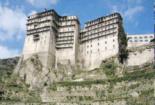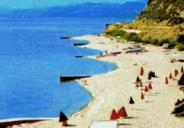Holy Mount of Athos
 Mount Athos is the easternmost prong and the most beautiful of all. It is known as the Holy Mountain (Agio Oros) and it is home to a semi-autonomous, all-male monastic community. Mt. Athos is the centre of the global Orthodox religion - an area of mystique, contemplation, and isolation. Rising majestically out of the sea to a height of 2,033 metres, Athos is covered with virgin forests and it is full of inaccessible mountain crests, thickly wooded slopes that plunge down into the deep sea and broad bays fringed by sandy beaches. It is considered to be one of the most beautiful landscapes in the world. Mount Athos is the easternmost prong and the most beautiful of all. It is known as the Holy Mountain (Agio Oros) and it is home to a semi-autonomous, all-male monastic community. Mt. Athos is the centre of the global Orthodox religion - an area of mystique, contemplation, and isolation. Rising majestically out of the sea to a height of 2,033 metres, Athos is covered with virgin forests and it is full of inaccessible mountain crests, thickly wooded slopes that plunge down into the deep sea and broad bays fringed by sandy beaches. It is considered to be one of the most beautiful landscapes in the world.
It was officially established in 963, when a monk named Athanasios the Athonite built the Monastery of the Great Lavra. Since the Middle Ages this peninsula has shared the fate of Macedonia: the glory of Byzantium, Ottoman domination, numerous revolutions, defeats, disasters, looting, hope and despair, and eventually Greek liberation, following the Balkan War in 1912.
 Nowadays, the appx. 2,000 monks live in "kellia", "kalyves", "kathismata", and "hesychasteria", which are various forms of small monastic communities or hermitages. The administrative centre of Mount Athos is the village of Karyes. The inhabitants of the monasteries keep Byzantine time and they use the Julian calendar. Surrounded by an enormous wealth of ecclesiastical treasures, rare icons and libraries stocked with precious manuscripts, they live according to a strict regime of prayer and labour, untouched by modern frivolities. This sacred area comprises 20 monasteries, including one Russian, one Bulgarian and one Serbian, built either on impressive cliffs, or in sheltered bays. There is an impressive photo gallery of the monasteries in the official Mount Athos website. Nowadays, the appx. 2,000 monks live in "kellia", "kalyves", "kathismata", and "hesychasteria", which are various forms of small monastic communities or hermitages. The administrative centre of Mount Athos is the village of Karyes. The inhabitants of the monasteries keep Byzantine time and they use the Julian calendar. Surrounded by an enormous wealth of ecclesiastical treasures, rare icons and libraries stocked with precious manuscripts, they live according to a strict regime of prayer and labour, untouched by modern frivolities. This sacred area comprises 20 monasteries, including one Russian, one Bulgarian and one Serbian, built either on impressive cliffs, or in sheltered bays. There is an impressive photo gallery of the monasteries in the official Mount Athos website.
 Although the peninsula of Athos is part of Greece, it enjoys certain autonomy. The "Holy Community" under the Ecumenical Patriarchate of Istanbul administers the region. This administrative body is composed of representatives of the monasteries, and maintains an office at Karyes (Iera Epistasia), where all visitors have to register upon arrival at Mount Athos.
Only men are permitted to enter Mount Athos. This rule, which is known as the avaton, forbids access to any female (including animals!), and is strictly observed. A maximum of 120 Greek Orthodox and 10 foreign visitors per day are allowed onto this sacred land. Men wishing to visit the Holy Mountain are admitted by special permit only. No video cameras are allowed and foreigners must prepare a number of documents in the Ministry of Macedonia and Thrace in Thessaloniki several days before their visit. Visitors may tour Mt. Athos by using the ancient stone-paved paths which lead from one monastery to another. However, they are advised to travel in-group or with a guide, since the dense vegetation has overgrown many of the paths and the sign posting is poor. Another traditional way to tour the mountain is by riding a mule. Mules and horses can be hired at Karyes, and come with drivers who are well acquainted with the routes on the mountains. Although the peninsula of Athos is part of Greece, it enjoys certain autonomy. The "Holy Community" under the Ecumenical Patriarchate of Istanbul administers the region. This administrative body is composed of representatives of the monasteries, and maintains an office at Karyes (Iera Epistasia), where all visitors have to register upon arrival at Mount Athos.
Only men are permitted to enter Mount Athos. This rule, which is known as the avaton, forbids access to any female (including animals!), and is strictly observed. A maximum of 120 Greek Orthodox and 10 foreign visitors per day are allowed onto this sacred land. Men wishing to visit the Holy Mountain are admitted by special permit only. No video cameras are allowed and foreigners must prepare a number of documents in the Ministry of Macedonia and Thrace in Thessaloniki several days before their visit. Visitors may tour Mt. Athos by using the ancient stone-paved paths which lead from one monastery to another. However, they are advised to travel in-group or with a guide, since the dense vegetation has overgrown many of the paths and the sign posting is poor. Another traditional way to tour the mountain is by riding a mule. Mules and horses can be hired at Karyes, and come with drivers who are well acquainted with the routes on the mountains.
 Ouranoupoli, 147 km from Thessaloniki, was founded by refugees from Asia Minor and is Mt Athos' main port. It is the last town on secular Mt Athos before you reach the monastic republic and its name translates as the "Gateway to Heaven". It is home to around 780 people and known for its sandy beaches. Boat trips from the port provide the ideal way to see some of the monasteries that cling to the rugged coastline of the peninsula like fairy tale palaces. At the extreme tip you get a clear view of Mount Athos rising like a great pyramid from the sea. Because of the ban on women, cruise boats are forbidden to approach closer than 300 metres from the shore. Yet, the incredible architecture of the monasteries, like something out of Tibet, can still be admired and the view is really unforgettable. Far from industry and large cities, the waters are brilliantly clear with sparkling visibility 30 or 40 feet down; kids will especially enjoy watching a three-dimensional ballet of shoals of fish and looking out for dolphins who enjoy giving a display for the entertainment of boat passengers. Ouranoupoli, 147 km from Thessaloniki, was founded by refugees from Asia Minor and is Mt Athos' main port. It is the last town on secular Mt Athos before you reach the monastic republic and its name translates as the "Gateway to Heaven". It is home to around 780 people and known for its sandy beaches. Boat trips from the port provide the ideal way to see some of the monasteries that cling to the rugged coastline of the peninsula like fairy tale palaces. At the extreme tip you get a clear view of Mount Athos rising like a great pyramid from the sea. Because of the ban on women, cruise boats are forbidden to approach closer than 300 metres from the shore. Yet, the incredible architecture of the monasteries, like something out of Tibet, can still be admired and the view is really unforgettable. Far from industry and large cities, the waters are brilliantly clear with sparkling visibility 30 or 40 feet down; kids will especially enjoy watching a three-dimensional ballet of shoals of fish and looking out for dolphins who enjoy giving a display for the entertainment of boat passengers.
The Prosforion fortress, built in 1344, is one of the most significant sights in the town. A stellar example of monastery architecture, it is the largest such structure in the whole Halkidiki and the best preserved. A small chapel dedicated to St. Constantine and Helen is located beneath it. The 13th century Fragokastro castle is located 3 km east of the village. Goat hair is used by the local womenfolk to make carpets featuring Byzantine designs and these are sold here, together with handicrafts fashioned by the Mt. Athos monks.
 In the centre of Karyes, the capital of Mt Athos, stands the building in which the Holy Community, consisting of representatives of each of the 20 monasteries, meets. In front of this there is the church of the Protaton, the Cathedral of Karyes, which is dedicated to the Dormition of the Virgin. The church of the Protaton was built by the Emperor Constantine the Great and features superb wall-paintings of the Macedonian (14th century) and Cretan (16th century) schools. In its sanctuary there is the miraculous icon known as "Axion Esti". The library of Karyes, housed in an old tower, has numerous manuscripts and some thousands of printed books. In the centre of Karyes, the capital of Mt Athos, stands the building in which the Holy Community, consisting of representatives of each of the 20 monasteries, meets. In front of this there is the church of the Protaton, the Cathedral of Karyes, which is dedicated to the Dormition of the Virgin. The church of the Protaton was built by the Emperor Constantine the Great and features superb wall-paintings of the Macedonian (14th century) and Cretan (16th century) schools. In its sanctuary there is the miraculous icon known as "Axion Esti". The library of Karyes, housed in an old tower, has numerous manuscripts and some thousands of printed books.
Towers
The establishment of the monks on the peninsula of Athos, as well as this area's prosperity during the past twelve centuries, are mainly due to the fact that the inhabitants of Agio Oros have continuously been exploiting the greatest part of agricultural and forest land there.
In order to organize the exploitation of their properties ("metochia") efficiently, the monasteries constructed large building complexes, and a tower was situated on the best part of the complex. Since the metochia were powerful economic units and they often became the target of several armed pillagers, towers were built so that the crops could be grown and protected from the looters.
Basic conditions for admission to Mount Athos
In accordance with the procedures established by the Greek Government, foreigners must obtain a written permit to visit Mount Athos from the "Holy executive of the Holy Mount Athos Pilgrims bureau", located at 14, Konstantinou Karamanli Avenue, 54638 Thessaloniki, Greece. (tel.: +30-2310-861611, fax: +30-2310-861811). Personal appearance and passport is required in order to obtain this permit, but no letter of recommendation is any more required, as it used to be in the past. The Office is open on Monday through Friday from 09:00 to 13:30, and on Saturday from 10:00 to 12:00. It is closed on the official holidays.
Generally, this office issues only 10 permits a day for non-Orthodox visitors (foreigners) and 100 for Greeks and orthodox visitors. Greeks can make reservations for their sojourn only by phone (tel.: 2310-833733). These permits are valid for a four-day visit on specific days. Extension of the four-day permit can be sought from Mount Athos authorities in Karyes. Upon arrival at Ouranoupolis, visitors must obtain a residence permit ("Diamonitirion"). Visitors must dress and behave respectfully and generally adapt to the lifestyle and eating habits of the monks.
|
